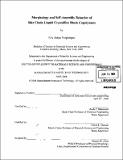| dc.contributor.advisor | Paula T. Hammond and Edwin L. Thomas. | en_US |
| dc.contributor.author | Verploegen, Eric Anton | en_US |
| dc.contributor.other | Massachusetts Institute of Technology. Dept. of Materials Science and Engineering. | en_US |
| dc.date.accessioned | 2009-01-30T16:40:08Z | |
| dc.date.available | 2009-01-30T16:40:08Z | |
| dc.date.copyright | 2008 | en_US |
| dc.date.issued | 2008 | en_US |
| dc.identifier.uri | http://hdl.handle.net/1721.1/44386 | |
| dc.description | Thesis (Ph. D.)--Massachusetts Institute of Technology, Dept. of Materials Science and Engineering, 2008. | en_US |
| dc.description | Includes bibliographical references. | en_US |
| dc.description.abstract | There is significant interest from both the academic and industrial communities for understanding and controlling the self-assembly behavior of complex macromolecular systems and has been an active area of research in recent years. Such systems can be designed to result in a wide range of nanoscale morphologies and greater functionality can be introduced with increasing complexity.This thesis focuses on the synthesis and characterization of a class of side chain liquid crystalline block copolymers (SCLCBCPs) that are based on a low glass transition temperature (Tg) siloxane backbone. Moieties that self-assemble into smectic liquid crystalline (LC) phases are covalently attached to the polystyrene-polyvinylmethylsiloxane (PS-PVMS) block copolymer backbone. Precise control over the functionalization of the LCs onto the functional siloxane backbone allows for unique control over the self-assembly and the resulting properties of the system. The LC content significantly affects the stability of the smectic mesophase and subsequently the interactions with the inter-material dividing surface (IMDS) with the PS domains. A strong preference for homogenous anchoring of the LC moieties relative to the IMDS is observed, and increasing the LC content intensifies the preference for this arrangement. Utilizing the effects of LC anchoring to alter the self-assembly behavior is a reoccurring theme throughout this work. Additionally, the mechanical properties of these materials can be precisely manipulated over several orders of magnitude through variations in LC content and the block copolymer backbone architecture.Several methods can be used to manipulate the morphologies of these materials once synthesized including, thermal annealing and mechanical deformation. | en_US |
| dc.description.abstract | (cont.) Thermal annealing provides additional mobility for self-assembly often resulting in morphological rearrangements. Mechanical deformation can be used to orient the self-assembled structures relative to an applied shear flow. Additionally, the self-assembled morphologies of spin cast into thin films were investigated. The presence of the substrate has significant effects upon the orientation of the morphologies; thermal annealing and variations liquid crystal content are shown to be useful tools for achieving a wide range of thin film morphologies. | en_US |
| dc.description.statementofresponsibility | by Eric Anton Verploegen. | en_US |
| dc.format.extent | 237 leaves | en_US |
| dc.language.iso | eng | en_US |
| dc.publisher | Massachusetts Institute of Technology | en_US |
| dc.rights | M.I.T. theses are protected by
copyright. They may be viewed from this source for any purpose, but
reproduction or distribution in any format is prohibited without written
permission. See provided URL for inquiries about permission. | en_US |
| dc.rights.uri | http://dspace.mit.edu/handle/1721.1/7582 | en_US |
| dc.subject | Materials Science and Engineering. | en_US |
| dc.title | Morphology and self-assembly behavior of side chain liquid crystalline block copolymers | en_US |
| dc.type | Thesis | en_US |
| dc.description.degree | Ph.D. | en_US |
| dc.contributor.department | Massachusetts Institute of Technology. Department of Materials Science and Engineering | |
| dc.identifier.oclc | 277139583 | en_US |
